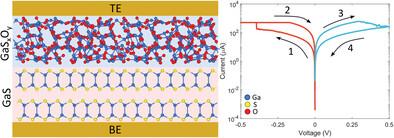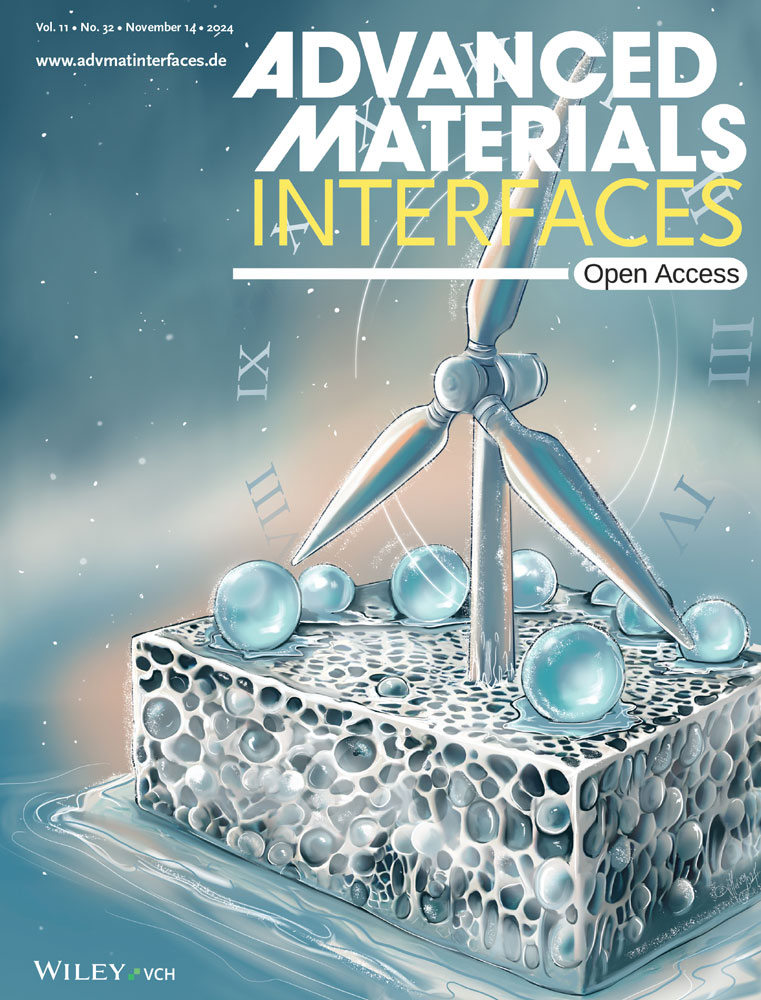Controlled Fabrication of Native Ultra‐Thin Amorphous Gallium Oxide From 2D Gallium Sulfide for Emerging Electronic Applications
IF 4.3
3区 材料科学
Q2 CHEMISTRY, MULTIDISCIPLINARY
引用次数: 0
Abstract
Oxidation of 2D layered materials has proven advantageous in creating oxide/2D material heterostructures, opening the door for a new paradigm of low‐power electronic devices. Gallium (II) sulfide (β‐GaS), a hexagonal phase group III monochalcogenide, is a wide bandgap semiconductor with a bandgap exceeding 3 eV in single and few‐layer form. Its oxide, gallium oxide (Ga

从二维硫化镓受控制备原生超薄非晶氧化镓,用于新兴电子应用
事实证明,二维层状材料的氧化在创建氧化物/二维材料异质结构方面具有优势,为低功耗电子设备的新模式打开了大门。硫化镓(II)(β-GaS)是一种六方相 III 族单质,是一种宽带隙半导体,其单层和少层带隙超过 3 eV。其氧化物氧化镓(Ga2O3)兼具大带隙(4.4-5.3 eV)和高介电常数(≈10)。尽管这两种材料都具有技术潜力,但原子级薄 β-GaS的受控氧化仍未得到充分探索。本研究的重点是利用氧等离子体处理技术对β-GaS进行受控氧化,以弥补现有研究中的重大空白。研究结果表明,在暴露于 10 W 氧气时,能够形成厚度为 4 nm 的超薄原生氧化物 (GaSxOy),从而形成 GaSxOy/GaS 异质结构,其下的 GaS 层保持完整。通过将这种结构集成在金属电极之间,并施加电压斜坡或脉冲电应力,研究了它们在电阻式随机存取存储器(ReRAM)中的应用。生成的氧化物具有超薄特性,可实现低操作功耗,每次操作的能耗低至 0.22 nJ,同时还能分别保持 350 次循环和 104 秒的耐久性和保持时间。这些结果表明,基于氧化的 GaSxOy/GaS 异质结构在电子应用,特别是低功耗存储器件方面具有巨大潜力。
本文章由计算机程序翻译,如有差异,请以英文原文为准。
求助全文
约1分钟内获得全文
求助全文
来源期刊

Advanced Materials Interfaces
CHEMISTRY, MULTIDISCIPLINARY-MATERIALS SCIENCE, MULTIDISCIPLINARY
CiteScore
8.40
自引率
5.60%
发文量
1174
审稿时长
1.3 months
期刊介绍:
Advanced Materials Interfaces publishes top-level research on interface technologies and effects. Considering any interface formed between solids, liquids, and gases, the journal ensures an interdisciplinary blend of physics, chemistry, materials science, and life sciences. Advanced Materials Interfaces was launched in 2014 and received an Impact Factor of 4.834 in 2018.
The scope of Advanced Materials Interfaces is dedicated to interfaces and surfaces that play an essential role in virtually all materials and devices. Physics, chemistry, materials science and life sciences blend to encourage new, cross-pollinating ideas, which will drive forward our understanding of the processes at the interface.
Advanced Materials Interfaces covers all topics in interface-related research:
Oil / water separation,
Applications of nanostructured materials,
2D materials and heterostructures,
Surfaces and interfaces in organic electronic devices,
Catalysis and membranes,
Self-assembly and nanopatterned surfaces,
Composite and coating materials,
Biointerfaces for technical and medical applications.
Advanced Materials Interfaces provides a forum for topics on surface and interface science with a wide choice of formats: Reviews, Full Papers, and Communications, as well as Progress Reports and Research News.
 求助内容:
求助内容: 应助结果提醒方式:
应助结果提醒方式:


